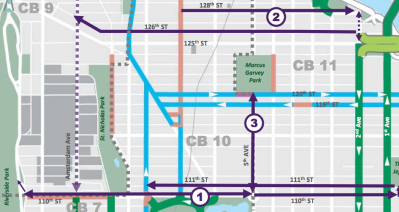CB 11 Transpo Committee Votes 7-0 for East Harlem Protected Bike Lanes

Protected bike lanes once again won big support in East Harlem. After Community Board 11 first endorsed protected lanes for First Avenue and Second Avenue by a vote of 47-3, then rescinded that support in the face of business opposition, the board’s transportation committee has put the complete street redesign back on the path to construction with a 7-0 vote of support, with one abstention.
“We’re certainly much more confident now with the project that we were in the past,” said committee chair Peggy Morales.
Two committee members who had been skeptical of the protected bike lanes said they’d been persuaded by two meetings of a working group convened at the suggestion of Borough President Scott Stringer. Supporters and opponents of the lanes sat down together with seven different city agencies to walk through exactly what protected bike lanes will mean for the neighborhood.
Frances Mastrota said that she’d been worried that the bike lanes would eliminate parking spaces and hurt local businesses, but was persuaded by Department of Health officials explaining that promoting walking, through pedestrian refuge islands, and cycling, would improve public health in a neighborhood that struggles with asthma and diabetes. Judith Febrarro, who still had a few concerns, voted for the lanes, reassured by the Fire Department that its trucks could use the lanes in an emergency and by the Sanitation Department that snow plowing would work with a floating parking lane.
In addition to helping foster some consensus, the bike lane working group also proposed some small modifications to the project. DNAinfo reports that the changes may include shortening some “mixing zones,” where cyclists share space with left-turning cars, to make room for parking.
The full board will vote on the bike lanes on March 20. If it votes for the lanes then, East Harlem — perhaps the neighborhood with the greatest gap between high cycling levels and poor cycling infrastructure — will finally get the protected lanes it has fought for so hard.
